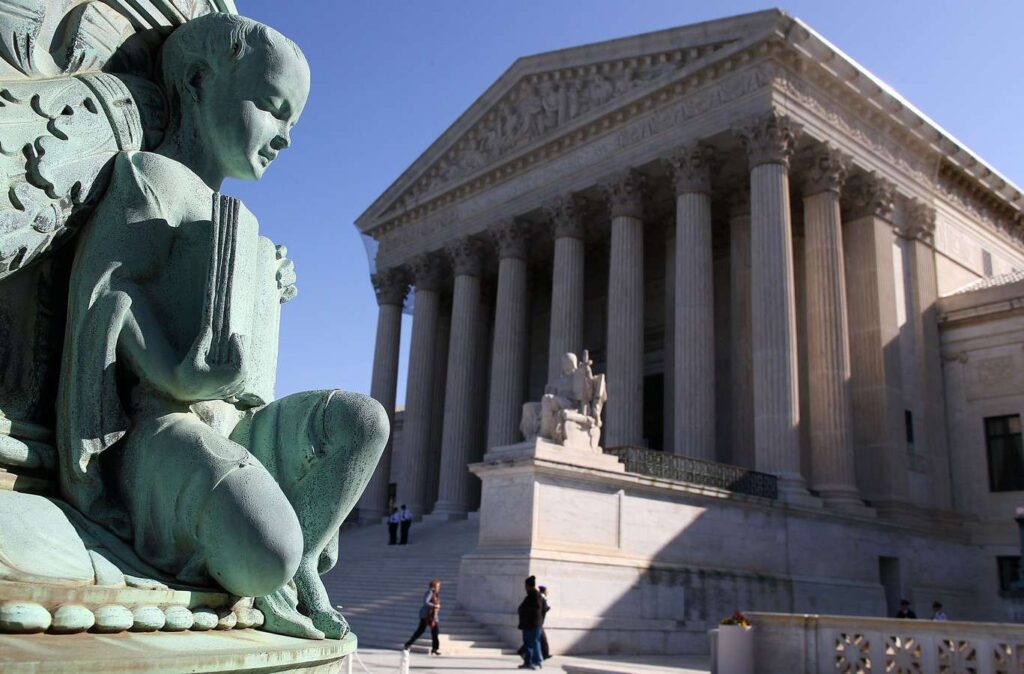Introduction
Often described as a cornerstone of American constitutional law, Gibbons v. Ogden (1824) established the federal government’s broad authority over interstate commerce, shaping the balance of power between state and federal governments.
Argued before the U.S. Supreme Court at a time when America was still in its infancy, the case pitted two steamboat operators—and, more broadly, two visions of government—against each other in a legal battle that would define the limits of state sovereignty.
Case Overview
- Full Case Name: Thomas Gibbons v. Aaron Ogden
- Citation: 22 U.S. (9 Wheat.) 1 (1824)
- Argued: February 5–9, 1824
- Decided: March 2, 1824
- Court: Supreme Court of the United States
- Chief Justice: John Marshall
- Decision: Unanimous (6–0) in favor of Gibbons
Factual Background
In the early 1800s, steamboats revolutionized trade and travel, especially along the Hudson River. The New York State Legislature granted Aaron Ogden an exclusive license to operate steamboats between New York and New Jersey, effectively granting him a monopoly.
Meanwhile, Thomas Gibbons, a former business partner of Ogden, began operating his own steamboat service under a federal coasting license issued under the Coasting Act of 1793.
Ogden sued Gibbons in New York state court, which ruled in his favor, barring Gibbons from entering New York waters. Gibbons appealed to the Supreme Court, arguing that his federally-issued license superseded any state law granting a monopoly.
Legal Issue
Does a state law granting exclusive steamboat navigation rights within its jurisdiction violate the federal government’s authority to regulate interstate commerce under the Commerce Clause of the U.S. Constitution?

Rule of Law
The Commerce Clause, found in Article I, Section 8, Clause 3 of the U.S. Constitution, grants Congress the power:
“To regulate Commerce with foreign Nations, and among the several States, and with the Indian Tribes.”
Chief Justice John Marshall interpreted the term “commerce” broadly to include not only the buying and selling of goods but also navigation and transportation between states.
Additionally, under the Supremacy Clause (Article VI), federal laws take precedence over conflicting state laws.
Application of the Rule
The Supreme Court, through Chief Justice Marshall’s opinion, made several key findings:
- Definition of Commerce: Marshall expanded the meaning of “commerce” to encompass all forms of commercial intercourse, including navigation. This was crucial, as steamboats were a central form of interstate commerce at the time.
- Scope of Federal Power: The Court found that Congress’s power to regulate interstate commerce was “complete in itself” and could be exercised to its fullest extent without interference from the states.
- Preemption of State Law: Because Gibbons held a valid federal coasting license, New York’s monopoly law could not supersede that authority. The New York law, in effect, infringed upon federal jurisdiction and was deemed unconstitutional.
- Federal Supremacy: The ruling reaffirmed the supremacy of federal laws over conflicting state regulations, particularly in matters where national uniformity is necessary—such as commerce.

Conclusion and Significance
The Supreme Court unanimously reversed the lower court decision, ruling in favor of Thomas Gibbons. The case marked a major victory for federal authority, establishing a precedent that states could not enact legislation that interferes with Congress’s constitutional power to regulate interstate commerce.
Gibbons v. Ogden became a foundational case in defining federalism and interpreting the Commerce Clause, a doctrine that has been cited in countless decisions involving transportation, civil rights, labor laws, and economic regulation.
Contemporary Relevance
More than two centuries later, Gibbons v. Ogden continues to influence legal debates, especially in cases where federal and state powers clash. For example:
- Civil Rights Legislation: The ruling supported Congress’s authority to pass laws like the Civil Rights Act of 1964, which regulated business practices affecting interstate commerce.
- Health Care & Environment: The Commerce Clause has also been invoked in major cases involving federal regulation of health insurance (e.g., the Affordable Care Act) and environmental protections.
Despite some pushback from modern advocates of “states’ rights,” Gibbons v. Ogden remains a touchstone in asserting that the Constitution empowers Congress—not individual states—to maintain a unified national economy.
Final Thoughts
Gibbons v. Ogden is more than just a historic dispute over steamboats—it is a landmark decision that shaped the very architecture of American federalism. By clarifying the broad reach of the Commerce Clause and reinforcing the Supremacy Clause, the case cemented the federal government’s role as the primary arbiter of interstate economic policy, ensuring consistency, fairness, and unity in national markets.
As the United States continues to navigate complex questions about the limits of government authority, Gibbons v. Ogden remains a beacon, guiding courts, lawmakers, and scholars through the often turbulent waters of constitutional law.
For Legal Educators & Students:
- Recommended Readings:
- The Federalist Papers (especially No. 42 by James Madison)
- The Oxford Guide to United States Supreme Court Decisions
- Commerce and the Constitution: The Gibbons v. Ogden Decision by Stanley Kutler
- Questions for Further Analysis:
- How might Gibbons v. Ogden be decided in today’s political climate?
- What are the implications of the decision for state-level economic regulations?
- Should the Court revisit the scope of the Commerce Clause in light of modern challenges?

